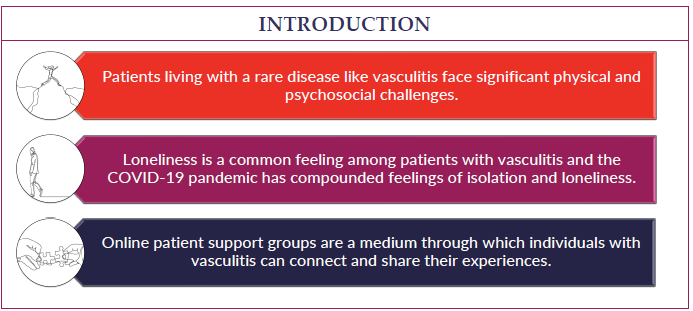Vasculitis Types
About Urticarial Vasculitis
Last Updated on February 5, 2024
Urticarial vasculitis is a form of vasculitis—a family of rare diseases characterized by inflammation of the blood vessels, which can restrict blood flow and damage vital organs and tissues. This form of vasculitis primarily affects the small vessels of the skin, causing red patches and hives that can itch, burn, and leave skin discoloration. Depending on the form of urticarial vasculitis, other organ systems may be affected.

Quick Facts

Number of cases worldwide unknown

Number of US cases unknown

Any onset age, but more common in ages 30-40

Rare in children

2 times more likely in females

Ethnic prevalence unknown
Urticarial vasculitis is a form of vasculitis—a family of rare diseases characterized by inflammation of the blood vessels, which can restrict blood flow and damage vital organs and tissues. This form of vasculitis primarily affects the small vessels of the skin, causing red patches and hives that can itch, burn, and leave skin discoloration. Depending on the form of urticarial vasculitis, other organ systems may be affected.
There are two categories of urticarial vasculitis named for the level of “complement proteins” in the blood, which play a role in the immune system.
- Normocomplementemic urticarial vasculitis refers to a normal level of complement proteins and is usually less severe, having little if any systemic (affecting multiple organs) involvement.
- Hypocomplementemic urticarial vasculitis refers to low levels of complement proteins and is more severe, having systemic involvement, and typically affecting the joints, lungs, kidneys, gastrointestinal tract, and eyes.
Treatment depends on the extent of symptoms and organ involvement. When the disease primarily affects the skin, antihistamines or nonsteroidal anti-inflammatory drugs (NSAIDs) such as ibuprofen or naproxen may relieve symptoms, with skin lesions disappearing over time. For more severe cases, glucocorticoids such as prednisone and/or other powerful drugs that suppress the immune system may be prescribed. Urticarial vasculitis can be a difficult-to-treat, chronic illness that can cause serious health problems, so ongoing medical care is essential.
The cause of urticarial vasculitis is not fully understood. Vasculitis is classified as an autoimmune disorder—a disease that occurs when the body’s natural defense system mistakenly attacks healthy tissue. In urticarial vasculitis, the inflammatory process may be set in motion by an infection such as hepatitis, a drug reaction, or the existence of cancer or another autoimmune disorder such as systemic lupus erythematosus, rheumatoid arthritis or Sjögren’s syndrome.
Urticarial vasculitis can affect people of any age, but it most commonly occurs in adults between 30 to 40 years of age. The disease is about twice as common in women than men. Urticarial vasculitis is considered rare; however, its precise frequency in the United States and worldwide is unknown.
Urticarial vasculitis usually begins with an eruption of skin lesions (wheals) and hives (urticaria), which cause itching, pain, and burning sensations. Skin patches are often red-rimmed with white centers and may have petechia—red or purple pinpoint spots caused by bleeding under the skin. The patches can be present for more than 24 hours and may leave a bruise-like skin discoloration as they heal.
Those with more severe, systemic involvement may also experience:
- Fever
- Joint pain
- Swelling of tissues under the skin
- Abdominal pain
- Swollen lymph nodes
- Shortness of breath
- Bloodshot or inflamed eyes
- Kidney inflammation
- Cardiac involvement
Common complications of urticarial vasculitis include skin pigmentation and occasionally skin ulcers. In more serious cases, individuals may have damage to their lungs and suffer chronic obstructive pulmonary disease, as well as eye and kidney complications.
There is no single diagnostic test for vasculitis, so your doctor will consider several factors including a detailed medical history, a physical examination, laboratory tests, and specialized imaging studies. A skin biopsy—surgical removal and analysis of a small tissue sample—can show inflammation and damage to the small blood vessels, helping to confirm the diagnosis. Low blood levels of certain complement proteins and the presence of an antibody against C1q (a protein in the complement system) help to confirm the diagnosis of hypocomplementemic urticarial vasculitis syndrome (HUVS).
Because urticarial vasculitis is often associated with other diseases, it may be necessary to do other tests to rule out underlying conditions. Tests of vital organs such as the kidneys and lungs may also be indicated, especially when the blood levels of complement proteins are low.
The course of treatment for urticarial vasculitis depends on the extent of symptoms and organs affected. When symptoms are limited to skin lesions, they may resolve on their own or may be relieved with minimal treatment such as antihistamines and nonsteroidal anti-inflammatory drugs (NSAIDs). If symptoms persist, hydroxychloroquine, colchicine or dapsone can be tried.
In cases of more severe organ involvement, drugs that suppress the immune system may be required such as glucocorticoids, azathioprine, methotrexate, mycophenolate mofetil or cyclophosphamide. Treatment may be intermittent for some, but many patients need to take medications for several years.
The medications used to treat urticarial vasculitis have potentially serious side effects such as lowering your body’s ability to fight infection, and potential bone loss (osteoporosis), among others. Therefore, it’s important to see your doctor for regular checkups. Medications may be prescribed to offset side effects. Infection prevention is also very important. Talk to your doctor about getting vaccines (e.g., flu shot, pneumonia and/or shingles vaccination), which can reduce your risk of infection.
Even with effective treatment, urticarial vasculitis can be a chronic disease with periods of relapse and remission. If your initial symptoms return or you develop new ones, report them to your doctor as soon as possible. Regular checkups and ongoing monitoring are important in detecting relapses early.
Effective treatment of urticarial vasculitis may require the coordinated efforts and ongoing care of a team of medical providers and specialists. In addition to a primary care provider, patients with urticarial vasculitis may need to see the following specialists:
- Dermatologist (skin)
- Rheumatologist (joints, muscles, immune system)
- Pulmonologist (lungs)
- Nephrologist (kidneys)
- Immunologist (allergies) or others as needed
The best way to manage your disease is to actively partner with your health care providers. Get to know the members of your health care team. It may be helpful to keep a health care journal to track medications, symptoms, test results and notes from doctor appointments in one place. To get the most out of your doctor visits, make a list of questions beforehand and bring along a supportive friend or family member to provide a second set of ears and take notes.
Remember, it’s up to you to be your own advocate. If you have concerns about your treatment plan, speak up. Your doctor may be able to adjust your dosage or offer different treatment options. Because urticarial vasculitis can be difficult to treat, a second opinion from a specialist doctor is highly recommended.
Living with a chronic condition such as urticarial vasculitis can be overwhelming at times. Fatigue, pain, emotional stress, and medication side effects can take a toll on your sense of well-being, affecting relationships, work, and other aspects of your daily life. Sharing your experience with family and friends, connecting with others through a support group, or talking with a mental health professional can help.
There is no cure for urticarial vasculitis at this time. For most people, urticarial vasculitis is a disease of the skin, with a minority of patients developing systemic organ involvement. When it is related to an existing autoimmune disease such as lupus or cancer, the prognosis may depend on the underlying disease. Because urticarial vasculitis may become chronic, follow-up medical care is essential.
Urticarial Vasculitis Videos
Vasculitis and the Skin Q&A


























































